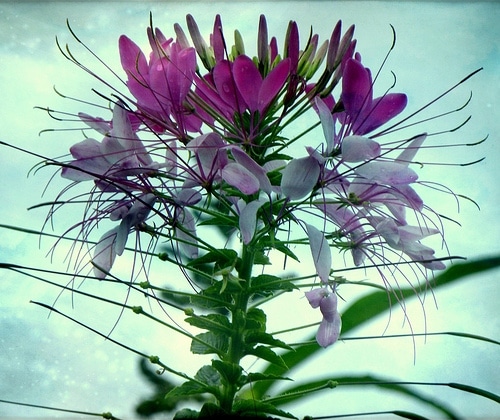Up until some time ago, Cleome genus belonged to a Caper family – Capparaceae. However, modern studies place it within Cleomaceae – a Bee plant family. These mostly annual, herbaceous plants are grown around the globe, thanks to their interesting appearance.
Cleome spinosa (synonym: C. pungens, C. hassleriana)
You will find it in flower markets by the name Spider flower or Bee plant (in North America), due to long stamens hanging out of 4 petal flowers. This flowering Cleome plant originates from South America. Landscapes of Brazil, Argentina, Uruguay, and Paraguay, which partly explains its exotic sexy flowers and colors.
Photo by twoblueday
Cleome spinosa – Spider flower
Looks and use in the garden
Cleome hassleriana belongs to the kind of upright species, being attractively long-blossoming. It usually goes from original pink – purple to light rose or white during next days. Because of these qualities, it is part of the group of plants that horticulturists use to emphasize some parts of the landscape. Therefore, it can occupy a central place in your garden.
Combine it with other annual flowers, perennials or as a “wall” flower, as a drapery (background) for lower floral borders. It is also produced as a cut flower.
Having a promising height, you can use it as a drapery Cleome by dinesh_valke
Maintain your Spider plant
Depending on the specific caring measures, interventions during the growing season (topping, pruning, planting density, etc.) plant habitus and height can be different. Hence, it can grow in ranges from 0.5 up to 1.5 m. Typical Cleome height also depends on the varieties of 0.7 – 1.2 m. But, with regular topping, it becomes highly lateral-branched and compact, with plant height between 0.5 – 0.7 m.
So, it is up to you to decide what your Cleome plant will look like.
The baseline of Spider flower decorative quality consists of a long vertical peak bloom made out of a large number of individual flowers size from 3 – 5 cm. These guys are gradually opening (emerging) from the base to the top of the inflorescence.
Flowers get the desirable airy look, for their thin stamens, 5 – 7 cm long, which by their appearance resemble spider legs. This is the reason Cleome just gets this exotic look.
Cleome’s fragrant colorful flowers
The most common flower colors are white, light pink and purple. There are also assortments in two-color petals with the contrasting stamens. The flowers are fragrant with a hint of musk. Probably there’s a name of the family bee plant.
Sometimes gardeners use this plant for its after-blooming-appearance. During flowering, while new top buds are forming and opening, lower – older ones readily discard their petals and cluster looks like stripped.
Cleome leaves are palmate shaped, usually with 3 – 7 leaflets, each of them reaching up to 15 cm, slightly hairy. Bottom leaves are thorny, so we wouldn’t recommend their planting in transit places. They vary in color, from green to gray-green, depending on the species variety.
Cleome growing technology
When it comes to continental parts of Europe, you can grow spider plant by sowing seeds in the greenhouse, or directly in the soil during spring. Sowing seeds in greenhouses should be done from October to January in pots directly into the planting substrate. Due to the extremely hard seed coat, it is recommended to pre-soak the seeds for at least 48 hours. Thus prepared seed will sprout in 16 – 20 days at 12-15 ° C temperatures.
After germination, it is necessary to provide convenient temperature conditions so you can replant the seedlings in a permanent place. Note this should be done after the last late frost in spring (you can consult your local weather forecast on this matter).
Temperatures and soil
Since it is foremost a tropical species, Cleome flowering lasts from June till the first autumn frosts. As for plant protection, during the production process, it is necessary to keep it aphids free.
After germination, it is necessary to provide convenient temperature conditions so you can replant the seedlings in a permanent place. Note this should be done after the last late frost in spring (you can consult your local weather forecast on this matter). Since it is foremost a tropical species, Cleome flowering lasts from June till the first autumn frosts. As for plant protection, during the production process, it is necessary to keep it aphids free.
This type of flower you should plant at a 30-40 cm distance on a sunny or semi-shade spots, in a well-draining fertile soil. Once Cleome grows and starts flowering, it usually tends to spontaneously reseed, because seeds will fall out of ripe nutlets (seed casings).
Cleome plant with ripe capsules containing seeds Photo by Bonnie James
No smothering, please
Then, you should pluck out new germinating plants in order to obtain your already growing high quality (not choked by newcomers) decorative plants. What is most important in terms of maintenance is that this plant is extremely modest in demands, but also very resistant to diseases and the impact of pollution.
Beside real spiders, it is not so bad to have a spider flower in your garden after all, isn’t it?
By Agnes Potkonjak

